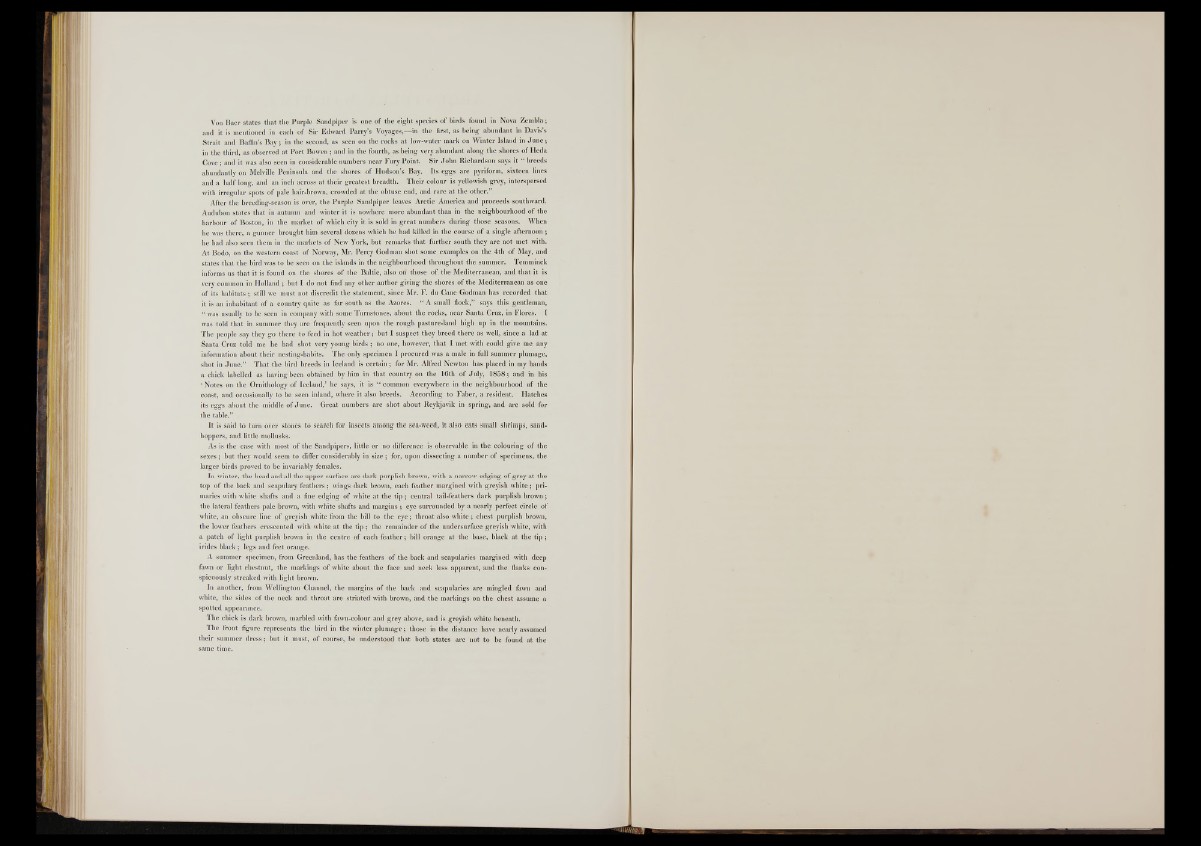
Von Baer states that the Purple Sandpiper is one o f the eight species o f birds found in Nova Zembla;
and it is mentioned in each o f Sir Edward Parry’s Voyages,—in the first, as being abundant in Davis’s
Strait and Baffin’s B a y ; in the second, as seen on the rocks at low-water mark on Winter Island in J u n e ;
in the third, as observed a t Port Bowen ; and in the fourth, as being very abundant along the shores o f Heda
Cove; and it was also seen in considerable numbers near Fury Point. Sir John Richardson says it “ breeds
abundantly on Melville Peninsula and the shores of Hudson’s Bay. Its eggs are pyriform, sixteen lines
and a half long, and an inch across at their greatest breadth. Their colour is yellowish grey, interspersed
with irregular spots of pale hair-brown, crowded at the obtuse end, and rare a t the other.”
After the breediug-season is over, the Purple Sandpiper leaves Arctic America and proceeds southward.
Audubon states that in auturnn and winter it is nowhere more abundant than in the neighbourhood o f the
harbour of Boston, in the market o f which city it is sold in great numbers during those seasons. When
he was there, a gunner brought him several dozens which he had killed in the course of a single afternoon ;
he had also seen them in the markets of New York, but remarks that further south they are not met with.
At Bodo, on the western coast of Norway, Mr. Percy God man shot some examples on the 4th of May, and
states that the bird was to be seen on the islands in the neighbourhood throughout the summer. Temminck
informs us that it is found on the shores o f the Baltic, also on those of the Mediterranean, and that it is
very common in Holland ; but I do not find any other author giving the shores o f the Mediterranean as one
of its habitats ; still we must not discredit the statement, since Mr. F. du Cane Godman has recorded that,
it is an inhabitant o f a country quite as far south as the Azores. “ A small flock,” says this gentleman,
“ was usually to be seen in company with some Turnstones, about the rocks, near Santa Cruz, in Flores. I
was told that in summer they are frequently seen upon the rough pasture-land high up in the mountains.
The people say they go there to feed in hot weather; but I suspect they breed there as well, since a lad at
Santa Cruz told me he had shot very young birds ; no one, however, that I met with could give me any
information about their nesting-habits. The only specimen I procured was a male in full summer plumage,
shot in June.” That the bird breeds in Iceland is certa in; for Mr. Alfred Newton has placed in my hands
a chick labelled as having been obtained by him in that country on the 16th of July, 1858; and in his
‘ Notes on the Ornithology of Iceland,’ he says, it is “ common everywhere in the neighbourhood of the
coast, and occasionally to be seen inland, where it also breeds. According to Faber, a resident. Hatches
its eggs about the middle of June. Great numbers are shot about Reykjavik in spring, and are sold for
the table.”
It is said to turn over stones to search for insects among the sea-weed, it also eats small shrimps, sand-
hoppers, and little mollusks.
As is the case with most o f the Sandpipers, little or no difference is observable in the colouring of the
sexes; but they would seem to differ considerably in size ; for, upon dissecting a nuoiber of specimens, the
larger birds proved to be invariably females.
In winter, the head and all the upper surface are dark purplish brown, with a narrow edging o f grey at the
top o f the back and scapulary feathers; wings dark brown, each feather margined with greyish wh ite; primaries
with white shafts and a fine edging of white at the t ip ; central tail-feathers dark purplish brown;
the lateral feathers pale brown, with white shafts and margins ; eye surrounded by a nearly perfect circle of
white, an obscure line o f greyish white from the bill to the e y e ; throat also wh ite; chest purplish brown,
the lower feathers crescented with white a t the t ip ; the remainder o f the undersurface greyish white, with
a patch of light purplish brown in the centre o f each feath e r; bill orange at the base, black a t the t ip ;
irides black; legs and feet orange.
A summer specimen, from Greenland, has the feathers of the back and scapuiaries margined with deep
fawn or light chestnut, the markings of white about the face and neck less apparent, and the flanks conspicuously
streaked with light brown.
In another, from Wellington Channel, the margins of the back and scapuiaries are mingled fawn and
white, the sides of the neck and throat are striated with brown, and the markings on the chest assume a
spotted appearance.
The chick is dark brown, marble.d with fawn-colour and grey above, and is greyish white beneath.
The front figure represents the bird in the winter plumage; those in the distance have nearly assumed
their summer dress; but it must, o f course, be understood that both states are not to be found a t the
same time.